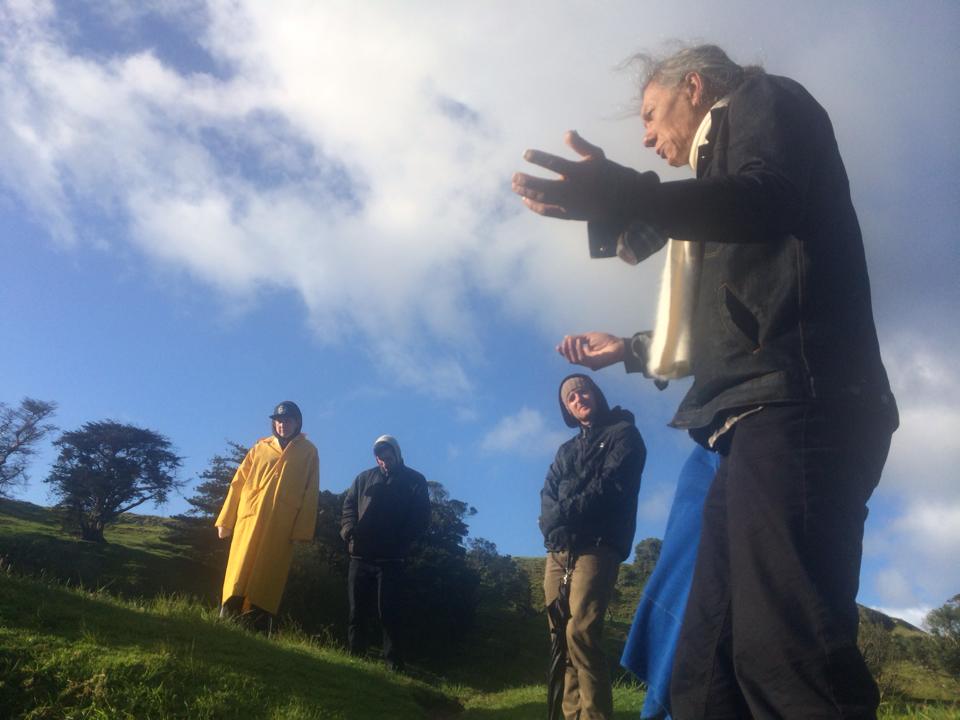Local Time were pleased to be asked to be part of the weekend events that formed part of the art project Other Waters by organisers Janine Randerson and Eu Jin Chua.
We invited Pita Turei (Ngai Tai ki Tamaki, Ngati Paoa, Nga Rauru Kiitahi) to work with us in considering Other Waters’ situation on and investigation of the Manukau Harbour and surrounds. In critical solidarity with the broader project’s acknowledgement of multiple histories of the harbour and surrounds, we began from our established method of the idea of camping as a means to consider mana whenua and basic needs in specific sites. From the questions of local permission and access to fresh water, we developed two contributions to the project.
First, for the Saturday of the Other Waters weekend we participated in pre-dawn, paimarire karakia on Mangere maunga, Te Pane O Mataoho, led by local kaumatua and advisor to the project Jeff (Koko) Tukua of Te Puea marae and Pita, followed by whakawhanaungatanga in the crater of the mountain amongst those who attended.
Second, for the rest of the weekend events, we collected drinking water from Te Puna O Hau, a significant puna wai in Onehunga, and made it available from the Te Tuhi caravan on Old Mangere Bridge, replicating the form of the similar gestures involved in Local Time—Waitaha Wai (2013) and Local Time—5th Auckland Triennial (2013).
Our attention was first drawn to Te Puna O Hau by Jeff Tukua, who described it as a year-round source of tuna and puha in his youth. He said that it was near the railway station but had been built over since, so we traced information on colonial businesses that had used the water to discover its exact location. It is, in fact, at the south end of Spring Street, its overflow still watering the small pocket of wetland that is the Bycroft Reserve, where its old name is marked, between industrial buildings over the railway line. A newspaper article from 1955 suggests that this name, Te Puna O Hau, is connected to a visit of the Tainui waka (see photo above). An article about the mill and biscuit factory whose owner, John Bycroft, gives his name to the site, too, describes the way it appeared in 1876:
“The mill is worked by a compound engine, driven simultaneously by steam and water, which gives it an advantage that no other mill in the district possesses. In the immediate vicinity of the mill is a large pond, fed by hidden springs, whence a constant and copious supply of water is obtainable for hydraulic power. This natural reservoir is about 200 yards in circumference, and in some parts thereof the water is 8 feet deep. Being spring water it is clear and pure—the best, we believe, at or near Onehunga. The pond is well stocked with carp and eels—some of the latter weighing about 40lb.” (“Bycroft’s Flour-Mill And Biscuit Manufactory At Onehunga”, New Zealand Herald, Volume XIII, Issue 4611, 24 August 1876, p.1.)
An Auckland Star story mentions a “new pumping station” at the site, opposite W. Sutherland & Co. Tannery, when that business was partly destroyed by fire in 1909. The spring is now used by Water Care for the metropolitan water supply in the area and pumped across to Mangere Bridge / Te Tai Tonga. Still gathered from a wide catchment to the north, it can supply 21 million litres a day. From the tap, as we accessed it, though, it is no longer completely fresh, but chemically treated.
Local Time are Alex Monteith, Danny Butt, Jon Bywater, Natalie Robertson. We acknowledge the generous support of Pita, Jeff, Vivky and whanau, and everyone who got up early on Saturday. We also thank Janine and Eu Jin for the invitation to work under the auspices of Other Waters.
